The blanket flower, with its fiery, daisy-like blossoms, is a testament to nature’s artistry and resilience, bringing a splash of vibrant, long-lasting color to any garden landscape. Its care is refreshingly straightforward, making it an excellent choice for both novice gardeners and seasoned horticulturists seeking low-maintenance beauty. Understanding the fundamental needs of this plant is the first step toward cultivating a spectacular display that will endure from early summer until the first frosts of autumn. Proper care revolves around mimicking its native prairie environment, which means providing plenty of sunshine, well-drained soil, and a relaxed approach to watering and feeding, allowing this hardy perennial to truly thrive and reveal its full, dazzling potential.
Embracing the blanket flower in your garden is an exercise in appreciating its inherent toughness, a quality derived from its origins in the sun-drenched, often arid plains of North America. This plant does not demand constant coddling or rich, heavily amended soils; in fact, it performs best under conditions that might cause other, more delicate perennials to falter. The key to its success lies in a simple mantra: provide excellent drainage and maximum sun exposure. When these two fundamental requirements are met, the blanket flower will reward you with an astonishingly prolific blooming season, requiring minimal intervention. This forgiving nature makes it an ideal candidate for rock gardens, xeriscaping projects, and sunny borders where consistent moisture is not always guaranteed.
The overall health and vigor of your blanket flower are directly tied to its environment, extending beyond just sun and soil. Air circulation, for instance, plays a crucial role in preventing common fungal diseases like powdery mildew, which can occasionally trouble the plant in humid or crowded conditions. Thoughtful spacing during planting ensures that each plant has ample room to grow and that air can move freely through the foliage, wicking away excess moisture. Regular garden maintenance, such as removing fallen leaves and debris from around the base of the plant, further contributes to a clean, healthy environment where pests and diseases are less likely to find a foothold.
Ultimately, the long-term success of cultivating blanket flowers hinges on a philosophy of “less is more.” These are not hungry plants that require a stringent feeding schedule, nor are they thirsty specimens that need daily watering. By resisting the urge to overwater or over-fertilize, you encourage the plant to develop a deep, robust root system that enhances its natural drought tolerance and resilience. A well-established blanket flower is a self-sufficient and rewarding addition to the garden, a vibrant beacon of color that asks for little but gives so much in return throughout the growing season.
Understanding soil and location requirements
Choosing the right location is the single most important decision you will make for the health of your blanket flower. This plant is a true sun worshipper, demanding at least six to eight hours of direct, unfiltered sunlight each day to produce its iconic, fiery blooms. A south-facing or west-facing position is typically ideal, as it ensures the plant receives the intense light it craves. Insufficient sunlight will lead to weak, leggy stems, reduced flowering, and a general lack of vigor. Before planting, take some time to observe your garden throughout the day to identify the sunniest possible spot, as this will lay the foundation for a thriving, floriferous plant.
More articles on this topic
The composition of the soil is just as critical as the amount of sunlight. Blanket flowers have a distinct preference for soil that is lean, sandy, or even rocky, with impeccable drainage. They are highly susceptible to root rot, a fatal condition that occurs when the roots are left sitting in waterlogged soil for extended periods. Heavy clay soils that retain moisture must be amended to improve their structure and porosity. Incorporating organic materials like compost is beneficial, but adding inorganic components such as coarse sand, perlite, or small gravel is even more effective at creating the sharp drainage that these prairie natives require to flourish.
When preparing the planting site, your primary goal should be to prevent water from ever pooling around the plant’s root zone. If you are working with dense, heavy soil, consider creating raised beds or mounds to elevate the root ball above the surrounding grade. This simple technique uses gravity to pull excess water away from the sensitive crown and roots. When digging the planting hole, make it two to three times wider than the root ball but no deeper, ensuring the crown of the plant sits at or slightly above the soil level. Backfilling with a mixture of native soil and grit will provide a stable yet freely draining medium for the roots to establish.
It is also important to consider the plant’s mature size and ensure adequate air circulation to prevent fungal issues. Space individual plants according to the specific variety’s recommendations, typically between 30 to 45 centimeters apart. This spacing allows sunlight to reach all parts of the plant and promotes airflow, which helps to keep the foliage dry and less prone to diseases like powdery mildew. Good air movement is especially important in more humid climates where fungal pressures are naturally higher. Proper spacing from the outset prevents the need for corrective transplanting later and fosters a healthier overall plant.
Watering and feeding strategies
One of the most appealing traits of the blanket flower is its remarkable drought tolerance once established. This resilience is a direct adaptation to its native prairie habitat, where rainfall can be infrequent. For newly planted specimens, consistent watering is crucial to help them develop a strong and deep root system. During the first few weeks after planting, you should water them thoroughly whenever the top few centimeters of soil feel dry to the touch. This initial period of attentive watering is an investment that pays dividends in the form of a hardy, self-sufficient plant in the long term.
More articles on this topic
Once the blanket flower has established itself, which is typically indicated by new growth and a robust appearance, you can significantly reduce the frequency of watering. For plants in the ground, natural rainfall will often suffice, except during prolonged periods of extreme heat and drought. During such dry spells, a deep watering once every week or two is far more beneficial than frequent, shallow sprinklings. This method encourages the roots to grow deeper into the soil in search of moisture, further enhancing the plant’s drought resistance. The key is to allow the soil to dry out completely between waterings, as this plant resents “wet feet” more than almost any other condition.
When it comes to fertilization, the blanket flower thrives on a lean diet. Rich, overly fertile soils or excessive application of high-nitrogen fertilizers can lead to a host of problems. It often stimulates lush, weak foliar growth at the expense of flowers, resulting in floppy stems that are unable to support the weight of the blooms. This weak growth is also more susceptible to pest infestations and diseases. In most average garden soils, the blanket flower will perform beautifully with no supplemental fertilizer at all. Its ability to extract necessary nutrients from less-than-ideal soil is one of its greatest strengths.
If your soil is exceptionally poor or sandy, a single, light application of a balanced, slow-release granular fertilizer in the early spring can be beneficial. Choose a formula that is low in nitrogen and higher in phosphorus and potassium, which support root development and flower production. Alternatively, a top dressing of well-rotted compost once a year will provide a gentle boost of nutrients without overwhelming the plant. Always avoid fast-acting liquid fertilizers, as they can easily burn the roots and promote the kind of weak, leggy growth that is detrimental to the plant’s structure and flowering capacity.
Routine maintenance and deadheading
Routine maintenance for the blanket flower is minimal, but a few simple tasks can significantly enhance its performance and appearance throughout the long blooming season. The most impactful of these tasks is deadheading, which is the practice of removing spent flowers. As soon as a bloom begins to fade, wither, and lose its vibrant color, it is best to remove it. This simple act serves a dual purpose: it keeps the plant looking tidy and, more importantly, it redirects the plant’s energy from seed production back into creating new buds and flowers.
The process of deadheading is straightforward and can be a relaxing garden activity. You can simply pinch off the faded flower head with your fingers, or for a cleaner cut, use a pair of pruning shears or scissors. Follow the flower stem down to the first set of healthy leaves or to a point where a new side bud is forming, and make your cut there. Regular deadheading, ideally performed every few days during the peak of the season, can dramatically extend the flowering period, ensuring a continuous display of color from early summer right through to the first frosts of autumn. This small effort yields a significant reward in the form of more blooms.
Beyond deadheading, keep an eye on the overall shape and health of the plant. Taller varieties of blanket flower may sometimes have a tendency to become a bit floppy or open in the center, especially after heavy rain or in slightly richer soil. You can provide support by using ring-style plant supports or by staking individual stems discreetly. Another technique, known as the “Chelsea chop,” involves cutting back the entire plant by about one-third to one-half in late spring. This delays flowering slightly but results in a sturdier, more compact plant with more branching and, ultimately, more flowers that are less likely to require staking.
As the season progresses into late autumn, the plant will naturally begin to slow down its growth. At this point, you have a choice regarding cleanup. You can cut the stems back to about 15 centimeters from the ground to create a tidier winter appearance. Alternatively, you can leave the spent stems and seed heads in place over the winter. This provides some structural interest in the dormant garden and the seed heads can offer a valuable food source for finches and other seed-eating birds. Leaving the foliage can also provide a small amount of extra insulation for the plant’s crown during the coldest months.
Promoting plant health and longevity
While blanket flowers are renowned for their hardiness, taking a few proactive steps can ensure they remain healthy and vigorous for many years. One of the best strategies for promoting long-term health is to divide perennial varieties every two to three years. Over time, the center of the plant clump can become woody and less productive, leading to diminished flowering and a less attractive, open shape. Division rejuvenates the plant, stimulates fresh growth, and provides you with new plants to expand your garden or share with others. This process is best done in the early spring just as new growth begins to emerge.
To divide the plant, carefully dig up the entire clump with a garden fork, being sure to get as much of the root system as possible. Once the clump is lifted from the ground, you can gently shake or wash off the excess soil to get a clear view of the root structure. Using a sharp spade, a garden knife, or even your hands, separate the clump into several smaller sections. Ensure that each new division has a healthy portion of both roots and top growth (or dormant buds). Discard the old, woody central part of the clump and replant the new, vigorous outer sections at the same depth they were previously growing.
Good sanitation practices are also fundamental to preventing the spread of diseases. Always use clean, sharp tools when pruning, deadheading, or dividing your plants. Disinfect your shears with rubbing alcohol or a bleach solution between cuts, especially if you are working with any plant material that appears diseased. Promptly remove and dispose of any yellowing or spotted leaves and clean up fallen debris from around the base of the plant. This reduces the available habitat for overwintering pests and fungal spores, ensuring a healthier start for the plant in the following spring.
Finally, consider the plant’s life cycle. While many blanket flowers are perennials, they are often short-lived, with a typical lifespan of two to four years. Allowing some of the later-season flowers to go to seed and self-sow can be an excellent strategy for ensuring a continuous presence in your garden. The resulting seedlings will often be slightly different from the parent plant, adding a delightful element of surprise. By embracing this natural cycle of renewal and periodically dividing the parent clumps, you can maintain a vibrant and healthy patch of blanket flowers in your garden indefinitely.
Common challenges and solutions
Despite their resilient nature, blanket flowers can occasionally encounter a few challenges, primarily related to environmental stress or pests. One of the most common issues is root rot, which is almost always a result of overly wet, poorly drained soil. Symptoms include yellowing leaves, wilting stems, and a general failure to thrive, even when the soil is moist. The only effective solution is prevention. Ensure your plants are sited in soil with excellent drainage from the outset. If you suspect root rot, you may need to carefully lift the plant, trim away any blackened, mushy roots, and replant it in a more suitable location or an improved soil mix.
Another issue that can affect blanket flowers, particularly in humid weather or overcrowded conditions, is powdery mildew. This fungal disease appears as a white, dusty coating on the leaves and stems. While it is rarely fatal, it is unsightly and can weaken the plant over time. To manage it, improve air circulation by thinning out the plant or moving it to a less crowded area. Avoid overhead watering, which wets the foliage and creates a conducive environment for fungal growth; instead, water at the base of the plant. For active infections, applications of horticultural oil, neem oil, or a potassium bicarbonate solution can be effective.
Pests are generally not a significant problem for blanket flowers, but aphids may occasionally be found clustered on new growth or flower buds. These small, sap-sucking insects can be easily managed. A strong spray of water from a hose is often enough to dislodge them from the plant. For more persistent infestations, insecticidal soap can be applied, ensuring thorough coverage of the affected areas. Encouraging beneficial insects like ladybugs and lacewings into your garden will also provide a natural and effective long-term control for aphid populations.
Occasionally, you might encounter a condition called aster yellows, a systemic disease spread by leafhoppers. Infected plants will exhibit strange, distorted growth, and the flowers may be stunted, discolored, or develop green, leafy parts where petals should be. Unfortunately, there is no cure for aster yellows. Any plant showing symptoms should be removed and destroyed immediately to prevent the disease from spreading to other susceptible plants in your garden. The best preventative measure is to control the leafhopper population, though this can be challenging. A healthy, well-cared-for plant is generally less susceptible to such severe issues.


















